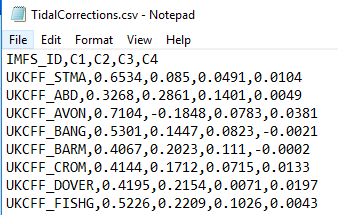Background
This page describes the implementation of the Tidal Peak Correction transformation. This transformation is a correction on the first next peak of the astronomical tide. It was implemented to correct the Surge tide prediction. A memo how it is implemented in the UK is attached to this page ; it describes the empirical method of tidal correction as a means of reducing the small inherent error in astronomical tidal predictions. Correction is made by applying a correction factor that reflects differences between observations and predictions for a few recent high water levels. To exclude the influence of diurnal inequality of high waters from the correction process, the adjustment is made using predictions and observations for alternate high waters, in accordance with the following correction algorithm:
In this function HWn is the observed high water level for tide number n, An is the astronomical prediction for the same tide and Sn is the storm surge component derived from the operational surge model for that tide. C1, C2, C3 and C4 are coefficients. The tidal peak correction transformation, calculates the part highlighted in red, which are the components with a C1..4 coefficient. The figure below shows which peaks are selected. In order to correct the next peak N, peak N-2, N-4 and N-6 are used to calculate the different components of the correction (the peaks to select are configurable in hte trasnformation function).
Configuration
The transformation uses three timeseries as input:
- An astro peaks (highs) timeseries, which contains all the previous peaks of the astronomical tide
- An observed peaks timeseries, which contains all the peaks of the observed water levels
- A surge forecast timeseries, which contains a number of surge forecasts
For each peak, a value is selected to be used for the calculation of the correction factor. So for peak N = -6, a value of the astro timeseries is selected, a value for the observed water level (within 2 hours of the stro peak) and a value of the surge forecast. The value of the surge forecast is selected from the time of the observed peak from the nearest surge forecast in time. This is best illustrated with the following example:
A surge forecast is run daily every 6 hours, e.g. at 00:00, 06:00, 12:00. 18:00. The -6 peak occures at 7:15, the function will use the surge forecast at 06:00, which is the closest forecast and use the value at 7:15 in the tidal correction transformation.
The selection procedure how the function works is (for peaks T0-2, T0-4, T0-6):
- Select astro peaks T0+1, T0-2, T0-4, T0-6
- Select Observed peaks T0-2, T0-4, T0-6
- For Astro Peak T0-2, find the time of the peak
- Try to find the observed peak that is closest to the Astro peak
- If the different in time between the astro peak and observed peak is less than 2 hours, use the observed peak time as reference time for T0-2. Calculate the function with Astro, Observed and surge forecast values for T0-2.
- If the difference in time between the astro peak and observed peak is more than 2 hours, calculation is stopped and a missing value is returned.
- Follow the same procedure for peaks T0-4 and T0-6
- Calculate the total surge correction using hte peaks and coefficients
The configuration of this trasnformation is provided below where the variables for astro and onserved peaks is provided as well as the variable for the surge forecast. In this example the astro peak variable is used to select the peaks and the time of the peaks is taken from the observed peak series.
The tidal correction transformation, the XML configuration is also attached to this page. The output of the transformation is a single value, which has the timestamp of the first next peak.
The coefficients can be configured as location attributes in a csv file, which is added to the LocationSets:





